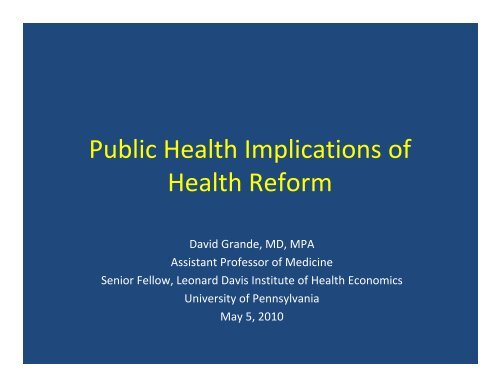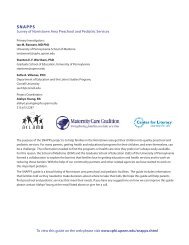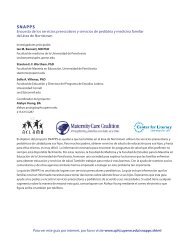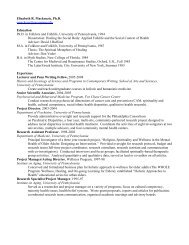presentation - Center for Public Health Initiatives - University of ...
presentation - Center for Public Health Initiatives - University of ...
presentation - Center for Public Health Initiatives - University of ...
You also want an ePaper? Increase the reach of your titles
YUMPU automatically turns print PDFs into web optimized ePapers that Google loves.
<strong>Public</strong> <strong>Health</strong> Implications <strong>of</strong><strong>Health</strong> Re<strong>for</strong>mDavid Grande, MD, MPAAssistant Pr<strong>of</strong>essor <strong>of</strong> MedicineSenior Fellow, Leonard Davis Institute <strong>of</strong> <strong>Health</strong> Economics<strong>University</strong> <strong>of</strong> PennsylvaniaMay 5, 2010
<strong>Public</strong> Cognitive Dissonance• <strong>Health</strong> care system is broken and costs too muchmoney• We should fix it by getting all the “waste” out <strong>of</strong> thesystem and through “prevention”• But we shouldn’t have anyone (government orinsurers) interfere with physician‐patient decisions• And we should cover the uninsured ‐ but weshouldn’t be taxed to do that
<strong>Health</strong> Re<strong>for</strong>m Goals• Major coverage expansion• Lower costs– Individuals and families– Society– Government• Eliminate unpopular insurance practices (e.g.pre‐existing conditions)• Improve health?– Uninsured vs Insured
The Coverage Approach• Insurance market re<strong>for</strong>ms– Eliminate medical underwriting ‐ premiums varybased on age, geography, tobacco use– Eliminate lifetime and annual limits– Regulated marketplace (“exchanges”)• Require Americans to carry insurance(en<strong>for</strong>ced through tax code)• Subsidize or cover ($$$)–
Uninsured in 2019Source: Congressional Budget Office
The Coverage Timeline• 2010– Adult children dependent coverage up to age 26– Children with pre‐existing conditions– High risk pool (state‐based)– Small business tax credits• 2014– Medicaid expansion– Establish state‐based insurance exchanges– Private coverage subsidies
High Risk Pool<strong>Health</strong> Re<strong>for</strong>m LawEligibilityBenefitsPremiums and Cost‐SharingFundingPre‐existing conditionUninsured x 6 monthsHHS establishes min. benefitsActuarial value: 65% <strong>of</strong> costsPremiums based on avg. risk populationVary by: age (4:1), geography, tobacco, family sizeOut <strong>of</strong> pocket max: $5,950/$11,900 (after premiums)$5B nationally (fixed pool)Timeline June 2010
Community <strong>Health</strong> <strong>Center</strong>s• Community <strong>Health</strong> <strong>Center</strong>s Trust Fund– Operational: $9.5 billion over 5 years• Increase capacity to serve 20 million new patients– Capital: $1.5 billion over 5 yearsSource: National Association <strong>of</strong> Community <strong>Health</strong> <strong>Center</strong>s
Beyond Coverage –Re<strong>for</strong>ms to Clinical Services
Primary Care Incentives• Payment increases <strong>for</strong> primary care– Medicaid rates increased to Medicare rates in2013 & 2014– Medicare primary care 10% bonus (2011‐2015)• Education initiatives to grow primary carework<strong>for</strong>ce and train <strong>for</strong> future practice models– Increase primary care residency positions andfunding– Support <strong>for</strong> Teaching <strong>Health</strong> <strong>Center</strong>s
Clinical Preventive Services• First dollar coverage (public and privateinsurance)• Mandated benefits– Empowers US Preventive Services Task<strong>for</strong>ce toprovide a minimum benefit standard (A and B)– ACIP recommended vaccines– Smoking cessation <strong>for</strong> pregnant women(Medicaid)• Wellness visits and personalized prevention
Source: Cohen et al., NEJM 2008Cost Effectiveness
Workplace Wellness• Promising approaches to improve healththrough incentive programs in the workplace• Legislation allows financial incentives ordiscounts <strong>for</strong> achieving wellness objectivesand provides tax credits to small businesses• Challenge: does it then permit medicalunderwriting?
Quality Incentives and Penalties• Hospital pay <strong>for</strong> per<strong>for</strong>mance (P4P) program– Future expansion to other institutional care• Implement financial penalties <strong>for</strong> hospitalacquired infections– 1% reduction in Medicare payments <strong>for</strong> outliers
Care Coordination• Goals:– Integrate clinical services to improve quality– Population focus– Align provider incentives– Lower costs• Strategies:– Readmission penalties (30d)– Bundled payments– Accountable care organizations (ACOs)– Independence at home (home care)
Readmission Penalties &Bundled Payments• Hospital readmission occurring within 30 days <strong>of</strong>discharge– Target conditions with risk adjusted readmission measures(heart failure, MI, pneumonia)– Encourages provider coordination– Challenges: low SES populations, optimal rate• Bundled payment <strong>for</strong> episodes <strong>of</strong> care (3 days priorto admission, admission, 30 days post‐discharge)– Inclusive <strong>of</strong> physician and hospital fees– Similar concept to prospective hospital payment (DRGs)but expanded set <strong>of</strong> services to align incentives– Challenges: allocating payments
Accountable Care Organizations• Voluntary Medicare pilot program• Concept: create quasi‐integrated provider networks ‐based on the idea that most patients and physiciansuse single hospitals• Financial Incentive: allows providers to share in costsavings– Providers report on quality and costs– Need robust primary care participation
Summary• Coverage: decrease number <strong>of</strong> uninsured by 32million (94% covered)– Benefits directed at lower end <strong>of</strong> income distribution– Residual uninsured population and demand <strong>for</strong> primarycare will sustain safety net demand• Delivery re<strong>for</strong>ms: first dollar coverage <strong>of</strong> preventiveservices, wellness, integration– Major expansion <strong>of</strong> clinical preventive services – need toaddress underuse– Integrating and coordinating care ‐ bundling and gainsharing opportunities as primary strategy






